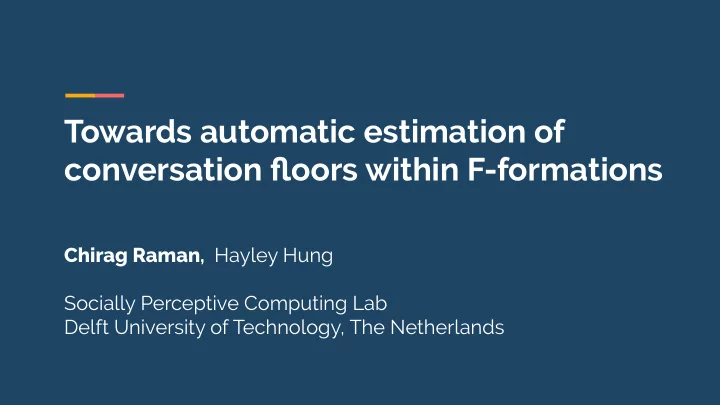

Towards automatic estimation of conversation floors within F-formations Chirag Raman , Hayley Hung Socially Perceptive Computing Lab Delft University of Technology, The Netherlands
MatchNMingle Dataset Motivation Research Questions Methodology Experiments Summary
RQ 1 Can we use observed speaker turns to infer the conversation floors within an F-formation? RQ 2 How does the cardinality of an F-formation affect the conversation floors developed within it? Motivation Research Questions Methodology Experiments Summary
“The floor is defined as the acknowledged what’s going-on within a psychological time/space. What’s going on can be the development of a topic or a function (teasing, soliciting a response, etc.) or an interaction of the two. It can be developed or controlled by one person at a time or by several simultaneously or in quick succession.” C. Edelsky, “Who’s got the floor?” p. 405 Motivation Research Questions Methodology Experiments Summary
An encounter between two participants exhausts a situation, forming a fully-focused gathering . With more than two participants, there may be bystanders who are not themselves so engaged, changing the gathering into a partly-focused one. If more than three persons are present, there may be more than one encounter carried on in the same situation, resulting in a multi-focused gathering. E. Goffman, “Behavior in public places: Notes on the social organization of gatherings” p. 91 Motivation Research Questions Methodology Experiments Summary
The co-existence of two turn-taking systems is the most decisive characteristic of schisming. H. Sacks, E. A. Schegloff, and G. Jefferson, “A simplest systematics for the organization of turn-taking for conversation” C. Goodwin, “Forgetfulness as an interactive resource ” There is an interface between the two simultaneous conversations during schisming. Systemic differences exist between overlapping speech , and schisming. M. M. Egbert, “Schisming: The collaborative transformation from a single conversation to multiple conversations” Motivation Research Questions Methodology Experiments Summary
Inferences! 1. We can infer schisms without audio data! 2. Simultaneous speech provides a link between the temporal and spatial notions of a conversing group! Motivation Research Questions Methodology Experiments Summary
Given a sliding window w of speaking duration d , consider a speaker to be a participant who speaks for the entire duration d The number of simultaneous speakers corresponds to the number of distinct conversation floors at that position of w Motivation Research Questions Methodology Experiments Summary
Choice of speaking window duration d Time Speech Speech S1 Speech Speech S2 Within-overlap Gap Between-overlap Scheme originally proposed by Heldner and Edlund and adopted by Levinson and Torreira Motivation Research Questions Methodology Experiments Summary
RQ1 - Distinct floors within an F-formation Examine the maximum number of simultaneous speakers over all positions of w . Motivation Research Questions Methodology Experiments Summary
RQ2 - Effect of cardinality on turn duration Train a Generalized Linear Model (GLM) on the data with an interaction factor between cardinality and speaking duration Assume Y i ~ P ( 𝜈 i ), and model 𝜈 i as follows: d i - speaking duration, c i - cardinality Motivation Research Questions Methodology Experiments Summary
RQ2 - Effect of cardinality on turn duration Coef ( 𝛄 ) Std. Err. z P > |z| Intercept 0.0626 0.339 0.184 0.854 Turn-duration 0.0057 0.002 2.296 0.022** Cardinality 0.1869 0.072 2.603 0.009* Turn-duration : cardinality -0.0025 0.001 -4.543 0.000006* * : significant at a level of 0.01 ** : significant at a level of 0.05 Motivation Research Questions Methodology Experiments Summary
RQ2 - Effect of cardinality on turn duration Post-hoc comparisons to ascertain differences between cardinalities Fit multiple GLMs to subset of data with each possible cardinality pair, and correct the p-values with six-way Bonferroni correction Motivation Research Questions Methodology Experiments Summary
RQ2 - Effect of cardinality on turn duration Cardinality Pairs Intercept ( 𝛄 0 ) d ( 𝛄 1 ) c ( 𝛄 2 ) d:c ( 𝛄 3 ) 4-5 0.196 0.855 0.794 0.403 4-6 0.364 0.0007 0.010 0.00002* 4-7 0.697 0.428 0.030 0.009 5-6 0.079 0.0008 0.016 0.00016* 5-7 0.434 0.413 0.043 0.052 6-7 0.275 0.006 0.657 0.024 d : duration, c: cardinality, * : significant at a level of 0.001 Motivation Research Questions Methodology Experiments Summary
Simultaneous speaker turns can be used as effective indicators of distinct conversations within a single F-formation An increase in cardinality of an F-formation correlates with a decrease in turn duration of simultaneous speakers Motivation Research Questions Methodology Experiments Summary
Thanks! Questions? Motivation Research Questions Methodology Experiments Summary
Recommend
More recommend